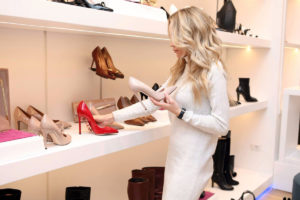
Do you go fishing? Have you ever caught a fish and had to decide if you were going to keep it or not? Sometimes there are limits to the number of a certain breed of fish you can catch and keep in a day. There are also size limits that are imposed on certain species, for example; a Large Mouth Bass might have to be fourteen inches long or longer in order to keep it in South Carolina. There are even seasons when certain fish cannot be kept if caught. As an example in Texas, according to texas.gov, Red Snapper season in federal waters closed on August 22 in 2018. In some situations where you can keep fish but only certain quantities you may have to decide if you are going to catch and release and keep the larger fish or take a chance and just reach your limit for the day. Shoplifting can be somewhat the same. You were wondering how fishing was going to tie in to Retail Loss Prevention weren’t you?
Now I am not talking about catch and release because a shoplifter does not fit the right height and weight limits. I am talking about whether a store management team makes a decision if they are going to prosecute shoplifters if they are caught period. Some store managers make a decision not to prosecute anyone for theft. The reasons are varied but may include the potential danger involved with stopping a crook or the risk of making a stop and the suspect does not have any merchandise (or says they do not and makes the manager question the decision to stop). Sometimes the decision not to prosecute rests on a dollar amount. A shoplifter might be stopped for an item under $20 but will not be prosecuted for that particular theft. Let’s explore why such decisions are made.
One of the major reasons for not prosecuting shoplifters, especially when the value of the item falls under a specific price point is that the amount of time spent on the case far exceeds what the value of the item was in the first place. If you choose to stop a shoplifter you will want the manager to write up some kind of report of the incident. In Loss Prevention we have incident reports to complete. There is also the time spent by the manager waiting with the shoplifter in an office for the police to show up. Depending on the jurisdiction police may issue a citation to appear in court for the alleged crime or they may take the suspect into custody. Follow all of this up with time spent in court prosecuting the case. By the time all is said and done a prosecuted case can be more costly to the merchant than just recovering the product and letting the suspect go.
Before you think that you have made up your mind on the direction you are going to take I would like you to think about the other perspective on this subject. Why would you decide to prosecute a shoplifting case? If you catch and detain someone, decide to release the suspect and they get into an accident you could potentially be held responsible. That is unlikely but has to be taken into consideration. If the suspect is a juvenile and you detain them you absolutely cannot release them on their own. Yes, you could choose to release them to a parent or guardian but there may be reasons it would be better to contact the police. I have seen my share of irate parents and later wished I had released the child to authorities.
While it may not seem like an important reason for you to prosecute a shoplifter I would ask you to consider one more thing. Each time a shoplifter gets
Catch and release when fishing may or may not be your choice. Prosecuting a shoplifter or not is up to you. Safety, efficiency, productivity and ramifications must all be taken into consideration. Ultimately the choice is up to the store owner. Just remember, whatever you decide to do be consistent and be fair with everyone you deal with.

 It’s here! The holiday season and there is a spirit of goodwill that hopefully we all share towards each other. For retail owners and managers the joyful spirit is boosted when sales are good as customers are buying gifts and purchasing foods for baking and holiday meals. For the most part people seem to be a bit more patient towards each other (except maybe in a mall parking lot where drivers fight for the best parking places). It really is the most wonderful time of the year!
It’s here! The holiday season and there is a spirit of goodwill that hopefully we all share towards each other. For retail owners and managers the joyful spirit is boosted when sales are good as customers are buying gifts and purchasing foods for baking and holiday meals. For the most part people seem to be a bit more patient towards each other (except maybe in a mall parking lot where drivers fight for the best parking places). It really is the most wonderful time of the year! As of September 2018, the national unemployment rate is down to 3.7% according to ncls.org. As a retail store owner thinks about what this means for you in terms of trying to hire to fill job openings including seasonal hiring for the holidays. With an employment rate of 96.3% that leaves a sparse workforce as a hiring pool. I have read articles by those who think that with a dwindling number of people seeking work employers are going to have to forego pre-employment background checks. They seem to believe that the need to hire outweighs any baggage the job candidates bring with them.
As of September 2018, the national unemployment rate is down to 3.7% according to ncls.org. As a retail store owner thinks about what this means for you in terms of trying to hire to fill job openings including seasonal hiring for the holidays. With an employment rate of 96.3% that leaves a sparse workforce as a hiring pool. I have read articles by those who think that with a dwindling number of people seeking work employers are going to have to forego pre-employment background checks. They seem to believe that the need to hire outweighs any baggage the job candidates bring with them.  Traditionally Black Friday has been the kick-off of the holiday shopping season. Families spent Thanksgiving together dining, celebrating, catching up with each other and maybe even watching a football game on television. Early Friday following Thanksgiving store employees would start reporting to work preparing for early openings which often took place at 6:00 am. Retailers had advertised their Black Friday specials (Door Busters) and customers would start queuing up at the doors ready to find bargains. The shopping would then continue into Saturday and even Sunday patrons continued to look for bargains to stretch their dollars further. Then something began to happen, stores started competing for those dollars by opening their doors earlier and earlier. We ( I did this for quite a few years) would report to work and 3:00 am for a 5:00 am store opening. The next year we moved to 2:00 am arrival for a 4:00 am opening. Today stores are opening their doors on Thanksgiving Day. There are Pros and Cons to this shift that I think is worth exploring in a bit more depth.
Traditionally Black Friday has been the kick-off of the holiday shopping season. Families spent Thanksgiving together dining, celebrating, catching up with each other and maybe even watching a football game on television. Early Friday following Thanksgiving store employees would start reporting to work preparing for early openings which often took place at 6:00 am. Retailers had advertised their Black Friday specials (Door Busters) and customers would start queuing up at the doors ready to find bargains. The shopping would then continue into Saturday and even Sunday patrons continued to look for bargains to stretch their dollars further. Then something began to happen, stores started competing for those dollars by opening their doors earlier and earlier. We ( I did this for quite a few years) would report to work and 3:00 am for a 5:00 am store opening. The next year we moved to 2:00 am arrival for a 4:00 am opening. Today stores are opening their doors on Thanksgiving Day. There are Pros and Cons to this shift that I think is worth exploring in a bit more depth. Black Friday and the holiday shopping weekend has generally been the time of the year that most retailers are excited about. This is the time when shoppers are going to pull out their wallets and spend money. Deep discounts, doorbusters, even gift bags for the first customers, have been used to entice shoppers to visit stores early. It has been so successful as a marketing tool that stores have even advertised early Black Friday sales in JULY! Unfortunately, it seems that there has been a dark cloud overshadowing this weekend and it is more ominous each year. This cloud is one that can turn a Black Friday into a Bleak Friday if a store owner isn’t prepared for it.
Black Friday and the holiday shopping weekend has generally been the time of the year that most retailers are excited about. This is the time when shoppers are going to pull out their wallets and spend money. Deep discounts, doorbusters, even gift bags for the first customers, have been used to entice shoppers to visit stores early. It has been so successful as a marketing tool that stores have even advertised early Black Friday sales in JULY! Unfortunately, it seems that there has been a dark cloud overshadowing this weekend and it is more ominous each year. This cloud is one that can turn a Black Friday into a Bleak Friday if a store owner isn’t prepared for it. A Target or Walmart store can and are able to fight shoplifting in their stores every day of the year.
A Target or Walmart store can and are able to fight shoplifting in their stores every day of the year.